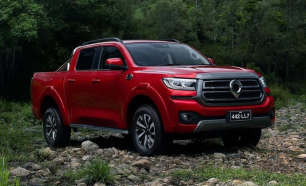GWM’s pricing for the Cannon was already pretty sharp, and when it took the axe to its price list late last year, the most basic Cannon became a $35,490 drive-away proposition. An obvious move to clear stock that would soon have the wrong year on its build-plate, the policy sure created some interest in the Cannon range as a whole.
Value for money is a major selling point with a vehicle like this, so how does the upgraded Cannon stand up? Pretty darn well, actually, and with a starting price of $40,490 you can forget about a stripped out specification or, indeed, having to pay more for a dual-cab layout or all-wheel drive.
Inside, you’ll find single-zone climate-control (with rear outlets), a wireless phone charger, power windows, the new 12.3 inch touchscreen, digital radio, voice command and artificial leather trim (seats and steering wheel), Apple CarPlay and Android Auto (which paired with my often recalcitrant phone seamlessly).
Eighteen-inch alloy wheels are standard, along with a chrome sports bar, auto LED headlights, auto high-beam, LED indicators and tail-lights, roof rails, power-folding exterior mirrors, side steps, damped tailgate, keyless entry and a spray-in bedliner.
The Ultra – and the version we’ve actually driven here - is next at $43,490 and adds leather-accented seats which are also heated and ventilated, a heated steering wheel, auto power windows, a six-way electrically adjustable driver’s seat (four-way for the passenger) ambient interior lighting and a light in the front footwells. Tinted rear windows are another Ultra addition, as is a tailgate step and, crucially, an electric sunroof.
Next step up is the Vanta at $45,490 which is fundamentally an Ultra with extra black bits. It’s identified by blacked-out alloy wheels, as well as a black sports bar, black side steps, and matt black wheel arches, exterior mirrors and door handles.
GWM tells us that the Ultra and Vanta are likely to be the big volume sellers.
The flagship Cannon is the XSR and $49,990 buys you a different grille, snorkel, stronger side-steps better able to tackle rocky tracks, and body-coloured mirrors and door handles. But a fair bit of the extra asking price goes towards an alternative driveline which we’ll cover in the under the bonnet section.
What’s missing? The lack of dual-zone air-con on any of the upper-spec models seems a bit strange, and a head-up display would be welcome.

